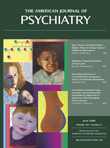Prevalence and Correlates of Estimated DSM-IV Child and Adult Separation Anxiety Disorder in the National Comorbidity Survey Replication
Abstract
Objective: Despite its inclusion in DSM-IV, little is known about the prevalence or correlates of adult separation anxiety disorder or its relationship to the childhood disorder. Results of the first epidemiological study of adult separation anxiety disorder, to the authors’ knowledge, and its relationship to childhood separation anxiety disorder are presented. Method: Data were from the National Comorbidity Survey Replication (NCS-R), a nationally representative survey of U.S. households. A fully structured, lay-administered diagnostic interview assessed a wide range of DSM-IV disorders, including separation anxiety disorder. No independent clinical validation was obtained of the assessment. Results: Lifetime prevalence estimates of childhood and adult separation anxiety disorders were 4.1% and 6.6%, respectively. Approximately one-third of the respondents who were classified as childhood cases (36.1%) had an illness that persisted into adulthood, although the majority classified as adult cases (77.5%) had first onset in adulthood. The assessment of separation anxiety disorder in the NCS-R was comorbid with other NCS-R or DSM-IV disorders and associated with severe role impairment in roughly half of the comorbid cases and one-fourth of the pure cases. The majority of people with estimated adult separation anxiety disorder are untreated, even though many obtain treatment for comorbid conditions. Conclusions: Criteria for adult separation anxiety disorder should be refined in future editions of DSM because the disorder is likely to be much more common in adults than previously recognized. Research is needed to develop and evaluate treatments that take into consideration its high comorbidity with other DSM-IV disorders.



